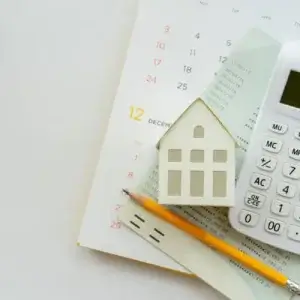Home / Home Loans / Mortgage offset accounts…




Key takeaways
- A mortgage offset account is a home loan feature that can help you reduce how much interest you pay over the life of your loan.
- Your lender will offset the balance of the account against your outstanding home loan amount when calculating your interest payable.
- You can save a significant amount of interest in the long term if you use a mortgage offset account wisely.
- Mortgage offset accounts may come with additional costs, so make sure you’re using it if you’ve got one.
How do home loan offset accounts work?
Selling Houses Australia host, Andrew Winter, explains how offset accounts work, and why they may be beneficial to you.



Hi, I’m Andrew Winter, host of Selling Houses Australia.
Finding the right home loan for you isn’t always about getting the lowest
rate or paying as little in fees as possible. While those things are certainly important,
focusing on them too much can result in you missing out on valuable features that
might’ve helped you save money on your home loan. One of the best-known home loan features out there
is the offset account, and coincidentally it’s also a pretty handy thing to have as a homeowner.
An offset account is essentially a transaction account which is linked to your home loan account.
And however much money you have in your offset account, that amount will be subtracted from your
home loan balance when your lender is figuring out how much interest to charge you for the month.
That means the more money you’ve got in your offset account, the less you’ll pay in home loan
interest, both over the short and the long term. And the neat thing is that for all intents and
purposes your offset account is a regular bank account; and works just like one too!
No delays or fees if you want to access the money you’ve currently got in there – just
transfer it or withdraw it like you would from any regular transaction account.
Some borrowers like to use their offset accounts as savings accounts,
forgoing the interest they could earn from their savings in the favour of the
interest they’ll save on their home loan using their savings.
Others may be less strategic about it, and just have their regular salary deposited
into their offset account and enjoy a minor interest reduction as a result.
But don’t get me wrong, neither approach is better or worse than the other.
There really isn’t a right or a wrong way to use an offset account,
but it is important to note that you’ll typically pay a monthly or annual package fee for the
privilege of having an offset account. So, you’ll want to make sure you’ll be
getting value out of the features you are paying for and saving enough on the interest
to make paying those fees worthwhile. If you’d like to compare home loans
that come with an offset account, Compare the Market has your back.
Their home loan comparison tool lets you specify which kinds of home loans and
features you are after, and then exclusively compare home loans that meet your criteria.
Once you’re done comparing, you can then apply for your chosen home loan using the same tool!
Best of all, it’s quick, easy, and free to compare home loans – so get started today
and take the first step on your home loan journey, with Compare the Market.
Expert tips for utilising a mortgage offset account
An offset account can be an invaluable home loan feature, but only if you know how to use it. With that in mind, our General Manager of Money, Stephen Zeller, has some offset account-related tips.

The higher your offset balance, the more you’ll save
Every dollar counts. As interest for a home loan is usually calculated and charged daily, the more money you can keep in your offset account on a regular basis, the lower your home loan interest charges will be. Subsequently, it’ll likely take you less time to pay off your home loan than it would if you didn’t have your surplus funds kept within an offset account.
Credit cards can pair with an offset account
Instead of using your savings in your offset account to cover your regular expenses, you could pay for them using a credit card. Before interest is charged on your credit card balance, pay it off using money from your offset account and you’ll avoid paying any interest. That way, you’re also maximising the interest-reducing potential of the money in your offset account.
An offset account may be less ideal for investment loans
If you have an investment home loan and are considering an offset account, you may want to discuss the idea with your accountant/financial planner. Property investors typically approach the treatment of interest on their home loan differently, as they can often claim a tax deduction on it come tax time. However, an offset account could still be appropriate for you depending on your financial circumstances.
Mortgage offset accounts explained
What is a mortgage offset account?

A mortgage offset account is a home loan feature that functions as a type of transaction account linked to your home loan. Your lender will ‘offset’ its balance against your outstanding home loan amount when calculating how much interest you need to pay on your home loan.
This means that you could potentially pay less interest on your home loan in the short- and long-term by utilising an offset account.
How do mortgage offset accounts work?
Offset accounts often function as an everyday transaction account, while providing a financial buffer against the interest on your outstanding loan. Provided you have money in your offset account, it can help you save by reducing the amount of interest you pay on your home loan balance.
Offset accounts can be 100% offset (meaning the entirety of the account’s balance is used in the calculation of your reduced interest repayment) or a partial offset, which generally means a percentage of the account’s balance is used. Your lender will calculate your daily interest amount using the net balance between your mortgage offset account and your home loan.
Interest on a home loan is typically calculated daily but will generally be charged monthly. Check with your lender to see how they calculate and charge interest.
The key to making a mortgage offset account work is to maintain enough of a minimum balance to make it worth your while, as offset accounts aren’t always free. Lenders can charge borrowers a monthly or annual fee or a higher interest rate for the privilege of having an offset account, so you need to make sure the feature is saving you enough money in interest to outweigh those package fees.
What are the different types of mortgage offset accounts?
There are two types of offset accounts available:
- 100% offset accounts. These are the most common form of offset account and are typically available with variable home loans, although you can find fixed rate home loans that offer an offset account. These accounts offset their full balance against your home loan balance, and therefore interest is only calculated on the outstanding net amount.
- Partial offset accounts. These use a portion of your offset account balance to reduce the interest payable on your home loan. This is typically expressed as a percentage (e.g. 50% or 75% offset). Some other lenders may offer partial offset accounts that use the full balance of the account, but instead charge a lower rate on the full balance.
Partial offset accounts tend to be less efficient than 100% offset accounts, although this will depend on your objectives and the home loan terms in question. You may decide that a particular home loan is the best-value option for you compared to the rest of the market based on its fees and features, even though it only offers a partial offset account.
Can I get a mortgage offset account on a fixed rate or investment home loan?
Offset accounts are typically available on variable rate loans but are less often found on fixed home loans. Some lenders do offer a fixed rate home loan with an offset account, but these may have restrictions; these could include things like minimum and maximum account balances or fees for depositing/withdrawing money.
Investment home loans can also come with offset accounts, it’ll just depend on the loan itself. Like with owner-occupier loans, offset account investment loans are more likely to charge slightly higher fees and interest rates, and are less common on fixed-rate loans.
Always check the key fact sheet of any home loan product you’re considering, so that you understand the fundamental details of the loan.
What are the benefits of an offset account?
Offset accounts can help you save money
An offset account can save you money on your home loan payments, which can ultimately help you pay off your home loan faster as it reduces your interest payable without having to directly reduce the principal component of your home loan.
Something else to consider is that a mortgage offset account can also function as a transaction account, meaning you can often use it just like an everyday account and make withdrawals or deposits. But remember, the more money you withdraw, the less your mortgage balance will be offset by. Conversely, the larger your offset account balance, the less you’ll pay in interest.
Offset accounts are flexible
The money in an offset account can be accessed at any time, which is handy for several reasons. By having those funds on-hand and readily accessible for an emergency, an offset account can provide a more flexible and easier-to-use option than a redraw facility, which could involve withdrawal fees and minimum or maximum withdrawal amounts.
And as mentioned, offset accounts can be used like any ordinary savings or transaction account. You can even have your regular salary deposited into it, which will help to increase the amount you’re offsetting against your home loan.
Remember that the interest on your home loan is typically calculated daily, so even if your salary is spent or saved elsewhere, the time it spends in your offset account will help to reduce your interest payable for the relevant period.
You may even be able to set up direct debits for any regular bills or payments you need to make out of your offset account, as well as attach a debit card to assist with everyday purchases. If you have an offset account, it’s generally considered good practice to try and make regular contributions to the balance, either by depositing regular savings in it or by making larger lump sum deposits.
Is a mortgage offset account better than just making additional payments on my home loan?
If you can afford to make additional repayments towards your loan and the terms of your loan permit it, that will help pay down both your principal and interest (depending on whether you’re currently on a principal and interest loan or an interest-only home loan), whereas an offset account only reduces your interest charges without affecting your principal.
That being said, an offset account gives you easy access to your money, whereas making additional repayments towards your home loan means that money is now locked up in the form of equity – unless you have a redraw facility, and even then, you may have to pay a fee to access it.
However, there’s no rule that says you can’t make additional repayments on a home loan as well as have a mortgage offset account. You’ll need to weigh up the pros and cons of both, some of which we’ve outlined here:
| Mortgage offset | Additional repayments | ||
| Pros | Cons | Pros | Cons |
|
|
|
|
Mortgage offset accounts vs other options
What is a redraw facility?

A redraw facility is a home loan feature that allows you to withdraw any additional loan repayments you’ve made. For example, if you’ve paid an extra $20,000 off the loan on top of your minimum repayments, your lender may allow you to withdraw up to that amount.
Any amount withdrawn will subsequently be added to the principal amount owing. Making additional payments towards your home loan can be beneficial as it may help you pay off your loan faster and reduce the interest you pay over the life of the loan.
However, as mentioned, redraw facilities may come with withdrawal fees and stipulated withdrawal limits. While this shouldn’t necessarily be a dealbreaker, it does make it crucial to compare your options across the entire market and, if you want a home loan with access to a redraw facility, find one that works for you.
Offset vs redraw: which is better?
It all depends on your personal priorities and financial situation. An offset account is an everyday bank account that also reduces the interest on your home loan, whereas a redraw facility gives you access to additional money you have previously paid towards your home loan.
While both can be useful, it’s up to you to decide whether one, both or neither of them suit your needs and long-term financial plan.
In terms of having access to your funds, offset accounts act like any typical transaction account, as the balance is available for you to withdraw or move at any time. On the other hand, redraw facilities only allow access to extra repayments you’ve made on your home loan up to the current loan limit.
When withdrawing money through a redraw facility, it may be available online or you might need to apply to do this and potentially wait a day or two before you can access your funds. Refer to your lender’s terms and conditions and read the product fact sheet to understand how your redraw facility works.
Regarding account-keeping fees, having an offset account on your home loan may be more expensive than more basic home loans that may come with a redraw facility.
Check whether there’s a redraw fee for using your home loan account’s redraw facility, and compare both the interest and comparison rates of any home loan products you’re considering.
Should I get a mortgage offset account or a savings account?
This is entirely up to you and will depend on the various interest rates on offer across the savings and offset account markets. It’s worth noting that these accounts do slightly different things.
A savings account will earn you interest on your own money, while an offset account will help you pay less interest on the bank’s money, which they lent you to buy a house with.
With this in mind, the interest you earn using a savings account will be subject to taxation, whereas the interest you don’t have to pay using an offset account is money saved rather than money earned and will therefore not be subject to immediate taxation.
You’ll want to take a look at the average interest rates for both products at any given time and decide which one will work better for you. For example, say that home loans have higher interest rates than savings accounts at the moment; this means that any money you place in a mortgage offset account will generally ‘work harder’ than funds stored in a savings account, by saving you more money than the savings account could earn you in the same period.
Of course, money sitting in a mortgage offset account will not grow unless you deposit more funds into it, as it does not attract interest. Savings accounts, on the other hand, help grow your wealth as they attract additional interest, so deciding between them is up to you and may depend on what your primary goal is: paying off your home loan faster or building up additional savings.
Managing a mortgage offset account
Is there a minimum amount I’m required to have in a mortgage offset account?
Banks and lenders generally won’t require you to have a minimum amount of money in your offset account before they start offsetting this against your home loan balance. However, this may differ from lender to lender, so check before committing to any specific home loan product.
Can I get a debit card linked directly to my offset account?
You’ll generally have a debit card connected to your offset account. The offset account essentially acts as a transaction account and having a debit card makes it easier to access the cash it holds.
How do I get my salary paid directly into my mortgage offset account?
To get your salary deposited straight into your offset account, you’ll need to get in touch with your employer or payroll office to provide them with your offset account banking details. Your bank or lender can supply you with the specific account details you’ll need to give to your employer.
Can I have multiple mortgage offset accounts?
Many lenders will allow you to open multiple offset accounts, whether for more than one home loan or for a single loan. You might want to consider this if you’re having your salary deposited into your offset account and want to divvy the money up for different purchases (e.g. car payments, household bills).
Meet our home loans expert, Stephen Zeller
Stephen has more than 30 years of experience in the financial services industry and holds a Certificate IV in Finance and Mortgage Broking. He’s also a member of both the Australian and New Zealand Institute of Insurance and Finance (ANZIIF) and the Mortgage and Finance Association of Australia (MFAA).
Stephen leads our team of Mortgage Brokers, and reviews and contributes to Compare the Market’s banking-related content to ensure it’s as helpful and empowering as possible for our readers.



